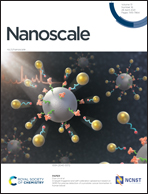Binding of tyrosine kinase inhibitor to epidermal growth factor receptor: surface-enhanced infrared absorption microscopy reveals subtle protein secondary structure variations†
Abstract
Surface-Enhanced Infrared Absorption (SEIRA) has been proposed as a valuable tool for protein binding studies, but its performances have been often proven on model proteins undergoing severe secondary structure rearrangements, while ligand binding only marginally involves the protein backbone in the vast majority of the biologically relevant cases. In this study we demonstrate the potential of SEIRA microscopy for highlighting the very subtle secondary structure modifications associated with the binding of Lapatinib, a tyrosine kinase inhibitor (TKI), to epidermal growth factor receptor (EGFR), a well-known driver of tumorigenesis in pathological settings such as lung, breast and brain cancers. By boosting the performances of Mid-IR plasmonic devices based on nanoantennas cross-geometry, accustoming the protein purification protocols, carefully tuning the protein anchoring methodology and optimizing the data analysis, we were able to detect EGFR secondary structure modification associated with few amino acids. A nano-patterned platform with this kind of sensitivity bridges biophysical and structural characterization methods, thus opening new possibilities in studying of proteins of biomedical interest, particularly for drug-screening purposes.



 Please wait while we load your content...
Please wait while we load your content...